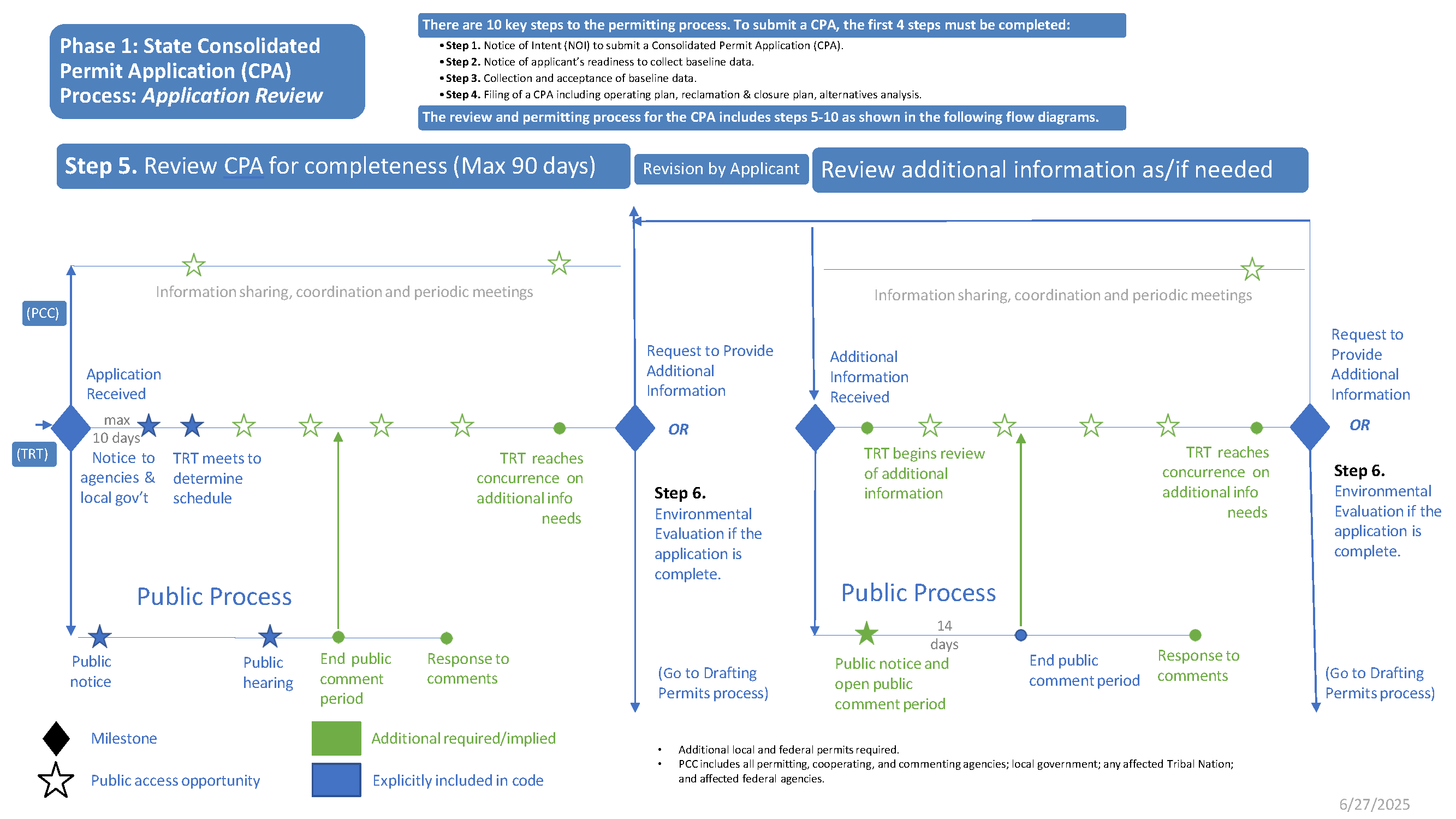(last updated 12/19/2025)
DOGAMI's Role
Under state law, Oregon uses a consolidated application process for administering state regulatory requirements for chemical process mines. Oregon state permitting agencies include the Department of Geology and Mineral Industries (DOGAMI), Oregon Department of Environmental Quality, Water Resources Department, and possibly the Department of State Lands and the Oregon Health Authority. Requirements from other participating agencies, such as the Oregon Department of Fish and Wildlife, the Department of Agriculture, and the State Historic Preservation Office will be incorporated into the DOGAMI operating permit. Other federal, state, or local permits may also be required.
Key agency roles are defined by their level of involvement:
Lead Facilitating Agency: DOGAMI provides coordination, accountability, and mediates any disagreements between agencies.
Permitting Agencies: Issue permits.
- DOGAMI
- Oregon Dept of Environmental Quality (DEQ)
- Oregon Water Resources Dept (WRD)
- Oregon Department of State Lands (DSL) (possibly)
- Oregon Health Authority (OHA) (possibly)
Cooperating Agencies: Achieve compliance with state standards or policies via permit conditions to DOGAMI permit.
- Oregon Dept of Fish & Wildlife (ODFW)
- Oregon State Historic Preservation Office (SHPO)
- Oregon Dept of Agriculture (ODA)
Permitting Process
Oregon's chemical mining permitting process goals include:
- Ensure coordination between state agencies, federal agencies, and local governments
- Consolidate baseline data requirements for needed state permits
- Provide for single comprehensive environmental evaluation and socioeconomic impact analysis
- Provide a clear path for application processing including required opportunities for public input and an efficient schedule with specified deadlines
- Designate a single lead agency to provide coordination, accountability, and to mediate disagreements between agencies
- Ensure environmental standards are met
The review and permitting process for the Consolidated Application includes Steps 5-10 as shown in the following flow diagrams.
Click here to display a larger flowchart in PDF format (2 pages).
The permitting process provides multiple opportunities for the public and interested stakeholders to participate in reviewing and commenting on consolidated permit applications and on consolidated permit requirements.


Environmental performance standards are in place to guide agencies' reviews with the intent to
minimize environmental damage through use of best available, practicable, and necessary technology and provide protection measures that are consistent with polices of the permitting agencies.
Environmental performance standards include:
- Use of 'Best Available Practicable and Necessary Technology' to minimize environmental damage and ensure compliance with environmental standards
- Requiring liners, leak detection, and leak collection systems to protect groundwater
- Ensuring air emissions, including dust, are properly controlled
- No discharge to streams, rivers, or groundwater
- Treatment of tailings to reduce toxics before discharge
- Long-term environmental monitoring at mine closure for as long as 30 years
- Proper management and storage of all chemicals, including petroleum products
- Routine environmental monitoring and reporting
Fish and wildlife performance standards include:
- Objective of zero wildlife mortality
- All chemical processing solutions and associated wastewater shall be covered or contained
- No overall net loss of habitat value
- No loss of existing critical habitat for state or federal listed threatened or endangered species
- Wildlife monitoring and mortality reporting
Reclamation performance standards include:
- Ensure protection of human health and safety (also livestock, fish, and wildlife)
- Ensure environmental protection
- Require certification to ODFW and ODA of a self-sustaining ecosystem comparable to undamaged ecosystems in the area
- Include backfilling or partial backfilling on a case-by-case basis
- Ensure adequate, long-term environmental monitoring
- Provide adequate financial security
The process incorporates the Project Coordinating Committee (PCC) and the Technical Review Team (TRT) in the application review and permit development process. PCC and TRT meetings are open for the public to attend. The PCC meetings have a public comment period.
Project Coordinating Committee: The PCC shares information and coordinates local, state, and federal permitting requirements to avoid contradictory requirements, facilitate the exchange of ideas, promote interdisciplinary decision making and optimize communication. The PCC ensures that the final permit(s) meet applicable standards. PCC meets throughout the permit pre-application, consolidated application, and permit development process. Membership includes appropriate State agencies, affected federal agencies, local governments, and interested Tribal Nations.
Technical Review Team: The TRT interdisciplinary team of agencies reviews the application and develops consolidated permit conditions that conform to Oregon regulations. The TRT approves the methodology for collection of baseline data and reviews the baseline data for completeness and accuracy. The TRT coordinates state agency permits to be consistent and to resolve conflicts. The TRT will determine the Best Available Practicable and Necessary Technology for chemical process mining that minimizes environmental damage.